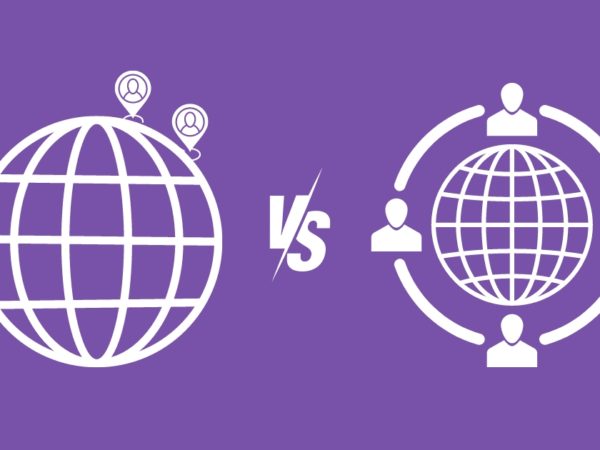Data changes every second in a fast-paced business environment. You need to apply agile analytics methodology to extract value from an ever-changing dataset.
Today, businesses make quick operations, marketing, sales, and product development decisions to adapt to the always-changing market dynamics.
Here comes agile analytics for data analysis. It offered a proven framework to extract actionable insights from data collected live and analyzed in sprints, just like the agile software development process.
If you are yet to learn agile business analytics basics and advanced concepts, keep reading until the end.
Agile Analytics and its Principles
<img alt="YouTube video" data-pin-nopin="true" data-src="https://kirelos.com/wp-content/uploads/2023/01/echo/hqdefault.jpg63bff4618942d.jpg" height="360" src="data:image/svg xml,” width=”480″>
Agile business analytics is a source approach that analyzes data that uses repetitive cycles of rapid analysis. Seek customer feedback and redo analyses to make better decisions on project or product development progress.
The parent agile product development project does not need to wait months for actionable data insights from a data analytics project. Instead, it gets frequent input from the BI team so that the end product matches the market trend.
It works the same way as an Agile or Scrum software development lifecycle. The BI analysts must run all the data analysis processes like data sourcing, data cleaning, data organizing, storing, wrangling, ETL scripting, visualizing, and insights reporting in short sprints.
The main objective is to make use of real-time data. Thus, the product or software development and business operations team can access live data insights compared to dated business insights in the traditional data analytics process.
Benefits of Agile Analytics
Transparency and Efficiency
When you follow the agile business analytics process, you can discover flaws and errors regularly. Thus, you can improvise the workflow and achieve flawless performance in future sprints.
Effortless Delivery
You can deliver more BI reports in less time when following this framework. The data analytics team can divide the datasets into small chunks and get on analyzing those chunks individually but with constant collaboration.
Simply compile the individual results in one report to draw a big picture or forecast.
Collaborative Approach
Agile analytics depend on extensive collaboration. Hence, your teams ensure that they follow the correct project path and that datasets do not pile up in silos.
Better Business Decision Making
Either you, as your own business or your clients, can make timely and effective business decisions with data insights from real-time data than dated data.
Timely Delivery of Insights
You can get data insights for business dynamics exactly when you need them. For example, when virtual meeting app requirements increased during the COVID-19 pandemic, those apps became popular that used agile analytics.
This BI approach helped companies understand the trend and publish a minimal viable product sooner than their competitors.
Why Should You Implement Agile Analytics?
Following the conventional business analytics approach may look promising since you think the process is easy. You set a goal, collect data, and analyze the data to justify the goal or provide insights to achieve the goal.
But there’s a fundamental problem with this BI methodology. Your data analytics team may invest too much time in setting up the tools for data manipulation and visualization. Sometimes, teams take months to perfect a few lines of code for data analysis.
After completing all other steps in a data analytics project cycle, you get a few business insights, data patterns, or data models that support or do not support the hypothesis or goal you set at the beginning of the project.
By this time, the market has changed a lot. There will be new demand, and the product or service you have developed will not get much attention.
Hence, you must implement the agile analytics framework to crunch raw data into useful analytics in short sprints. It is highly welcome if you can minimize the sprints within a few days or a maximum of a week.
How to Implement Agile Analytics
Implementing agile business analytics should be similar to that of the parent software or product development project. It will follow the five stages of the agile framework, and these are:
- First, you must discover the best ways to analyze the data according to your industry standards. You also need to choose efficient BI tools at this point.
- In the second phase, create a list of key requirements, locate data sources, clean the datasets, and create the first sets of dashboards for the stakeholders to review.
- The third phase is all about standardizing the key tasks of business intelligence. For example, you must streamline data sources, databases, IT infrastructures, the ETL process, data extraction, data security, etc.
- In the fourth phase, you must scale the output of data analytics like dashboards, charts, cloud dashboards, etc.
- The final phase is about supporting the team or clients who will consume the dashboard for further business reasons. Also, in this phase, you must collect feedback and channel those to the next sprint.
Best Practices for Agile Analytics
Since the outcome of agile analytics will have a direct impact on the business decision you make, you must follow a proven and risk-free agile analytics pathway. Find below the best practices that successful and top businesses follow in their organizations:
#1. Incremental Delivery
As the name suggests, agile analytics is the data analysis practice in a short sprint to discover the best value from real-time datasets.
To make the data analytics process more efficient and cost-effective, you must ensure that the agile teams deliver insights, reports, data models, data-backed business decisions, performance analysis, etc., incrementally.
#2. Ready to Accept Changes
You must nurture a mindset within the team that the market dynamics will change as the project progresses. Hence, the team may need to adapt according to the change.
The ultimate goal is to create data analytics reports that are timely and effective for the current market status.
#3. Frequent Delivery
The data analytics team must ensure they’ll deliver a minimal viable product or MVP at the end of each week or fortnight. This will ensure that the overall agile development process benefits from analyzing real-time datasets.
#4. Agile Collaboration
The data analysis team must be ready to collaborate with every project stakeholder. There should be online collaboration tools that will facilitate easy collaboration within short notice of meeting requirements.
These are the critical best practices that an agile analytics project, team, or business must follow. Find below some additional practices that will help you succeed in this field:
- Create a supportive environment for your business intelligence analysts.
- The data analytics team must also ensure reliable data and patterns for the downstream processes, so that related tasks and subtasks do not impact negatively.
- The agile analytics team manager must ensure that the project goes according to the schedule, budget, and scope.
- You must innovate the agile sprints of data analytics and report generation by making the process more error-free, adapting to the previous feedback, and delivering results better than the last sprint.
- Should there be any drastic change from the client’s end, all the teams must sit together to improvise the project pathway to minimize the project’s cost.
Agile Analytics: Learning Resources
#1. Agile Analytics | Coursera
This Agile Analytics course from Coursera will teach you to build a strong analytics infrastructure for your team so that you can drive more value by integrating it into the core of your business.
From this resource, you will also learn to naturally integrate your workflow with actionable analytics and combine your persona and problem-centric hypotheses with analytics. It will take around 15 hours to complete this course.
The course language is English, but subtitles are available in Arabic, French, Italian, German, Russian, Spanish, and more. Furthermore, you can re-schedule the deadline if you cannot make time for the coursework. This course is 100% online, and you get a shareable certificate upon successful completion.
#2. Become an Agile Business Analyst in Scrum | Udemy
This Udemy course will help you learn the concepts and standards of the Agile extension to the BABOK Guide. You can also utilize the knowledge to become an AAC-certified professional.
Moreover, it allows you to master major business analytics techniques, such as product roadmaps, user personas, user stories, retrospectives, MVPs, and Kano analysis. This resource will also make you familiar with the job roles of an Agile Business Analyst and how they do their jobs.
Therefore, you can adapt to the agile mindset needed for a business analyst. The course comprises 13 downloadable resources, 9 articles, and 3 hours of on-demand video material. You also get a certificate of completion and full lifetime access to all materials.
#3. Agile Analytics
This book demonstrates how to adapt traditional Agile methods carefully to address the unique requirements and attributes of DW/BI projects. It offers you knowledge on how to drive more innovation, value, and quality to any project (analytics, data warehousing, business intelligence) with the help of Agile methods.
Here, the author introduced platform-agnostic Agile solutions. It helps to integrate diverse operational, legacy, and specialty infrastructures. The resource shows practical examples of managing analytics development teams with diverse skill sets. Reading this book will enable you to support fast-growing and enormous data volumes.
The book discusses proven solutions for IT professionals, database administrators, data warehouse professionals, BI specialists, or database developers. It also helps you improve business alignment, mitigate business risks, and accomplish better results.
#4. Analytics: The Agile Way
If you use analytics but see things through the perspective of traditional IT projects, that is not the right way to do things. Read this book to find out how the big names in the industry, like Google and Nextdoor, are approaching contemporary analytics.
This resource will also demonstrate how these organizations apply Agile analytics techniques instead of traditional domains like engineering and software development. As a result, employees of these smart companies can understand and act many times faster than their traditional counterparts.
This book uses a perfect blend of case studies, examples, and exercises. It also demonstrates how this novel mindset opens the door for immense opportunity. If you belong to an organization that is ready to embrace uncertainty and move with the fast-paced world, this is an ideal book for you.
#5. How To Be An Agile Business Analyst
The book is about using agile to implement your business analysis skills. Do not let the name of this book confuse you. Here, agile means your approach, not the methodology.
Using this resource, business analysts can become effective team members who can work agilely. It tells you how to apply your skills to add value to your team. You can also learn about the five characteristics of an agile business analyst from this book. It will also tell you how to adopt those characteristics.
Moreover, the resource also explains your roles and responsibilities and helps you explore the impact of an agile approach on a regular business analysis process. If you follow this book properly, you can prove yourself to be a useful member of your team.
#6. Data Curious: Applying Agile Analytics
Citizen data analysts are filling the gaps left by traditional business intelligence processes. But these new data analysts lack a background in data processing technology. This book will help these professionals fill in the void in their knowledge.
It will take you through the fundamentals of data literacy. As a result, tech-savvy business professionals will understand the possibilities and be able to ask the right questions.
Moreover, this resource can give practical advice on making your teams self-sufficient and bringing positive change.
Conclusion
Agile analytics is your best bet to gain a competitive edge in your industry. It enables you to make timely decisions in less time without making any errors.
Also, your data analytics team can efficiently analyze massive datasets coming from multiple directions when they follow the agile data analysis process.
Do try out the virtual learning courses and books mentioned above. They will help you gain knowledge and confidence around agile analytics that you can apply in real-world business cases.
Next up, the best business intelligence platforms and Edge Analytics.
![Kirelos Blog Agile Analytics: An Ultimate Guide [+6 Learning Resources] Agile Analytics: An Ultimate Guide [+6 Learning Resources] Analytics Business Operations](https://s3.eu-central-1.wasabisys.com/kirelos/wp-content/uploads/2023/01/12135205/agile-analytics-an-ultimate-guide-6-learning-resources-950x358.png)


